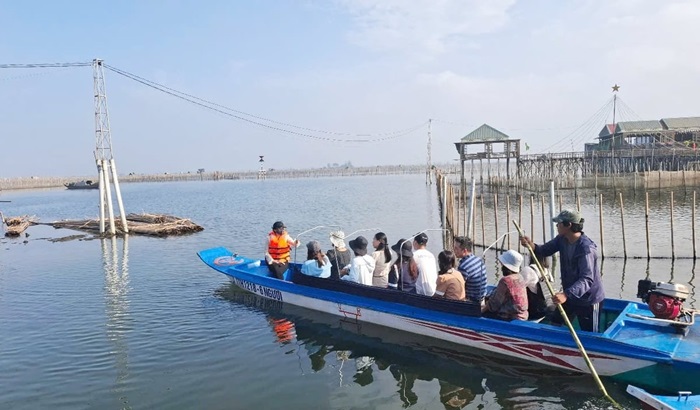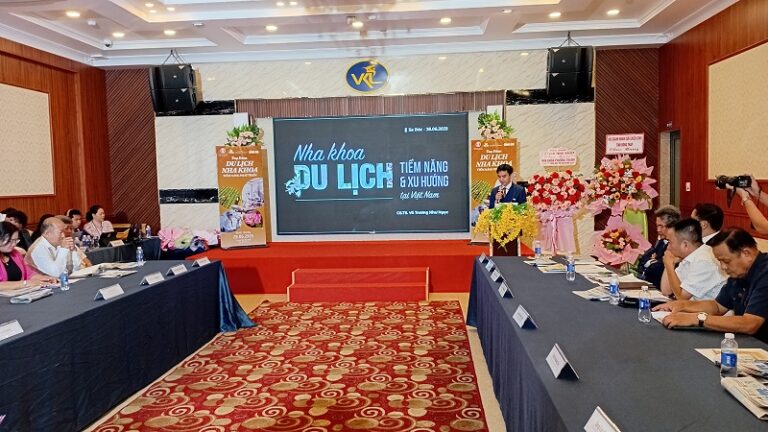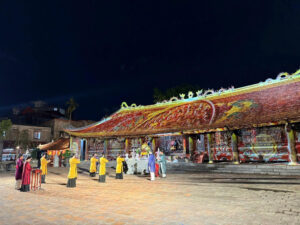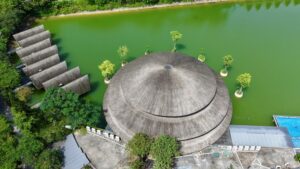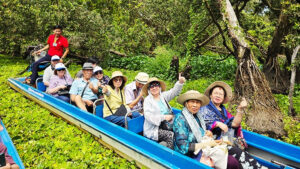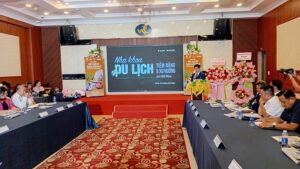From a girl who could only help her parents with farming - growing rice and corn, Ms. A Lang Be has taken her opportunity to become a tour guide when the legendary Kazan waterfall in Doi village (Thuong Lo commune, Nam Dong district), considered “a natural breast”, bestows an eco-tourism site on the local community.
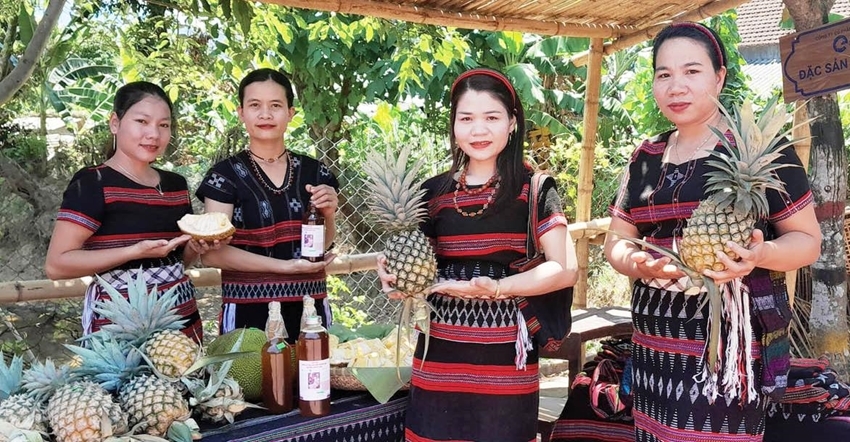
Women in Doi village introduce local agricultural products
Every day, the Kazan waterfall still flows in a natural manner, bringing cool water from the high mountain to the residents of Doi village.
The construction of the entrance to this waterfall has been proposed to the local government by A Lang Be, and the funds for the building of a concrete road have also been raised from Co Tu people in Doi village. The two sides of the road are lined with stream stones, combined with flowers and trees being planted and electric light bulbs being installed, to create beautiful scenes for the area surrounding the Kazan waterfall.
At night, the flickering electric light bulbs are still bright enough to light the entrance to the waterfall for visitors. The huts have also “emerged” along the stream thanks to the ideas and efforts of Ms. Be and the residents of Doi village.
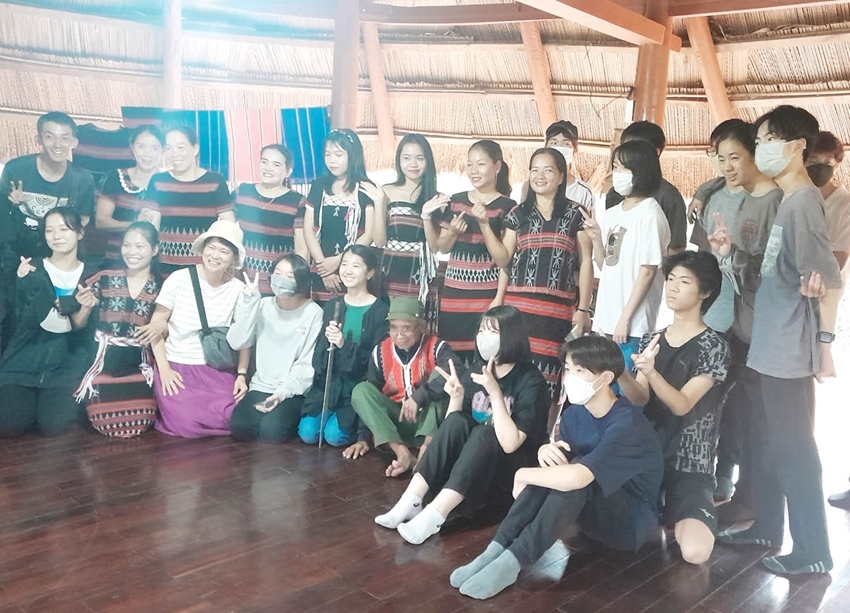
Tourists take photos in Doi village
In the summer noon at the foot of A Chup A Ngop mountain, dipping ourselves in the water of Kazan waterfall really helps lower the blistering heat of the sun. While engrossed in the flowing stream, visitors may suddenly hear female voice saying: “Nham chao ti noo he!” (Hello guys). That is the affectionate and familiar invitation of A Lang Be to tourists every time they visit Kazan waterfall.
At nightfall, the foot of A Chup A Ngop mountain becomes quiet; there are a few flickering fires of groups of tourists camping along the stream together with the tung tung da da dance or zum folk singing echoing from the communal house in Doi village. “Kazan waterfall is transforming,” said A Lang Be.
Under the dim moonlight, A Lang Be told the myth of Co Tu people which is associated with the Kazan waterfall. Legend has it that there once used to be a waterfall originating from a love story of two people who loved each other passionately at the foot of A Chup A Ngop mountain. Suddenly one day, the man joined the army and never returned. The girl waited desperately for her lover until she died and turned into a stream of water. Since then, the waterfall has been named Kazan by Co Tu people of Doi village.
A Lang Be said that zum folk singing also originated from the love story of Co Tu people during the chaotic war which separated one from the others. After the war, they returned to their homeland, reunited in the love of neighbors and comrades. Hence, zum folk singing is organized every time the people gather and unite in festivals or community activities.
A Lang Be then led us to the communal house in Doi village to actually hear and see Co Tu girls performing the tung tung da da dance and zum folk singing. Not only could we see the smooth movements, but also hear the passionate lyrics whose meanings really get to the bottom of tourists’ soul.
According to A Lang Be, the tung tung da da dance, with boys beating gongs while girls singing and dancing, is a way of expressing the respect and gratitude to heaven, earth, and their ancestors for a year of favorable conditions and good crops, as well as praying for another new year of bumper crops.
A Lang Be said: “When I just started exploiting the Kazan waterfall as an eco-tourism site, I had to meet with the village elders and chief day and night to listen to the traditional songs and dances of the people so that mass performance teams could be formed to serve the entertainment needs of tourists as well as their demands for discovering Co Tu culture. I was taught the dance of tung tung da da and the zum folk singing by the village elders, and then gave instructions to the mass performance teams of Doi village. I was also responsible for the mobilization and selection of young men and women in the village as part of this mass performance teams.”
In her story, A Lang Be talked about the incident when she reluctantly became a “tour guide”. Ever since she was a child, whenever she followed her mother to the fields, she could feel the beauty of the pristine mountains, streams, and waterfalls that nature bestows on local people very clearly. After graduating from high school and getting mature, the beauty of the mountains and forests in Doi village becomes even much greater in A Lang Be’s mind.
That fierce passion prompted Ms. Be to immediately think of exploiting Kazan waterfall as an eco-tourism destination, with the desire to contribute to changing the lives of the residents in Doi village through tourism services. Her aspiration was realized when the local government embarked on the construction of a community tourist area in Doi village. At that time, A Lang Be looked for every solution to participate in community tourism. Ms. Be, now an officer of Thuong Lo commune, was filled with overwhelming joy when being “recruited” as a “tour guide” in the Kazan waterfall community.
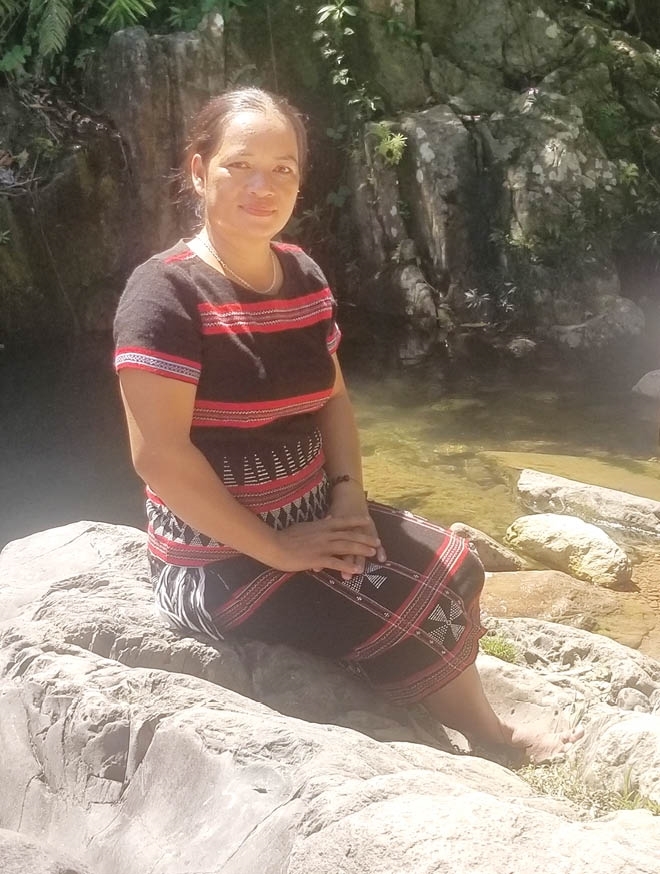
A Lang Be next to Kazan waterfall stream
Many tourists and local people know about the natural beauty and waterfall tourism services through this female guide. Coming to Kazan waterfall, visitors are served specialties of the mountains and forests of the indigenous people such as com lam (bamboo-tube rice), grilled chicken, hamlet pork, stream snails, stream fish, wild vegetables, etc. Ms. Be guides visitors to experience the craft of knitting, weaving Zèng; experience mountains and forests and hear about the meaning of trees and animals associated with human life so that they can develop a deeper love for nature.
In spite of reluctantly being a tour guide, A Lang Be was trusted by the local government to be the director of the Doi Village Community Tourism Cooperative when it was first established. Although in the position of director, she also plays the part of a staff member in charge of selling souvenirs such as Zèng and knitting products, as well as a tour guide. In many festival programs to serve tourists, she still participates in performances with the mass performing team to serve tourists whenever there is a shortage of participants.
Despite neither being a professional tour guide nor specializing in the field of tourism, A Lang Be has undergone many tour guide training courses and visited many tourist eco-tourism attractions in many provinces and cities. Her daily joy is simply being able to interact, exchange and share about the beauty of culture, traditions and characteristics of her compatriots with visitors.
Having met foreign tourists who do not understand Vietnamese for so many times, Ms. Be must use all means of signs and actions to help tourists better experience and understand the culture of Co Tu people. This not only brings joy to her, but also delights foreign tourists.
Having visited many places such as Co Tu village in the Northern Regions of Vietnam, Mang Den (Kon Tum province), or A No waterfall (A Luoi district), etc., A Lang Be’s constant concern is that Kazan waterfall has not been invested and exploited commensurately so far, despite its abundant potential and advantages. This waterfall has welcomed 18 groups of domestic and foreign tourists to visit, which confirms that the value and beauty that nature offers are great. However, the resources of the locality and the community are beyond the ability to invest in building a worthy eco-tourism site, resulting in the meagerness of community tourism services in Kazan.
Kazan waterfall is one of the community tourist attractions in the province that is being invested by the province and Nam Dong district, heading towards a professional community eco-tourism destination. Upon leaving this legendary stream, we witnessed bulldozers building a parking lot and a road to the waterfall. This, perhaps, is the beginning of a “big investment” at the Kazan waterfall that A Lang Be has always longed for.
Story and photos: Hoang Trieu


